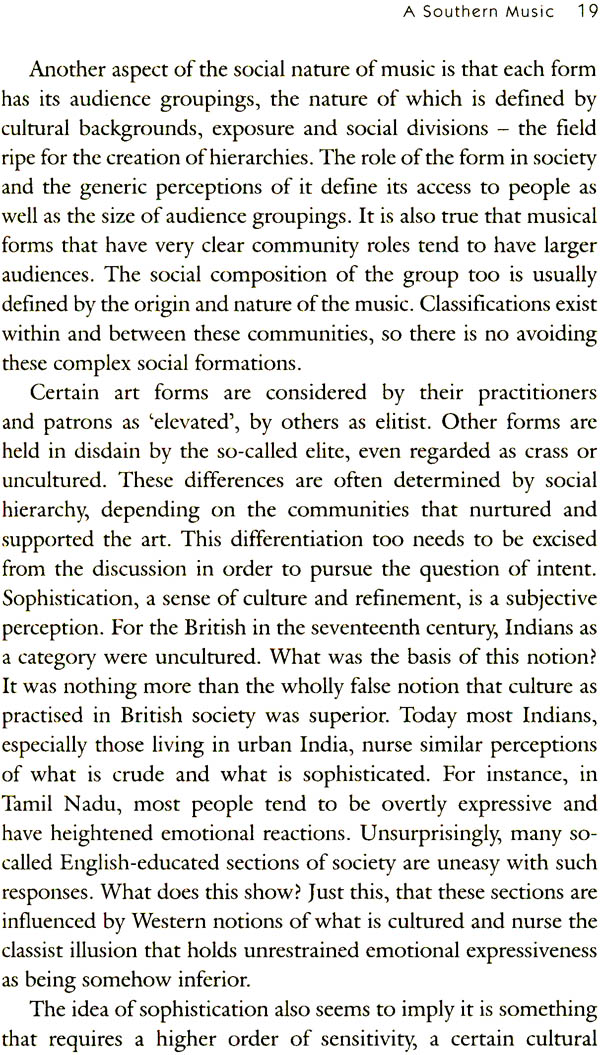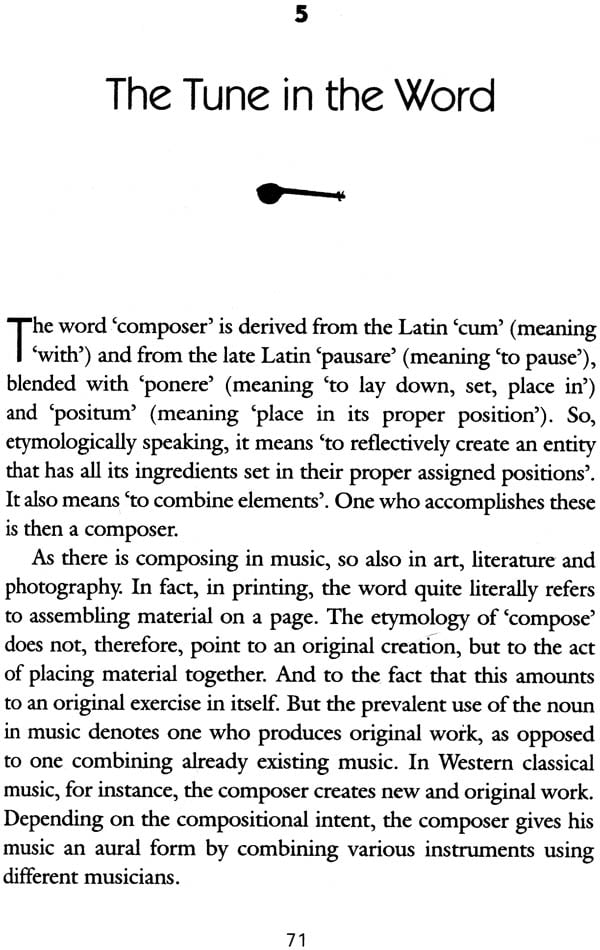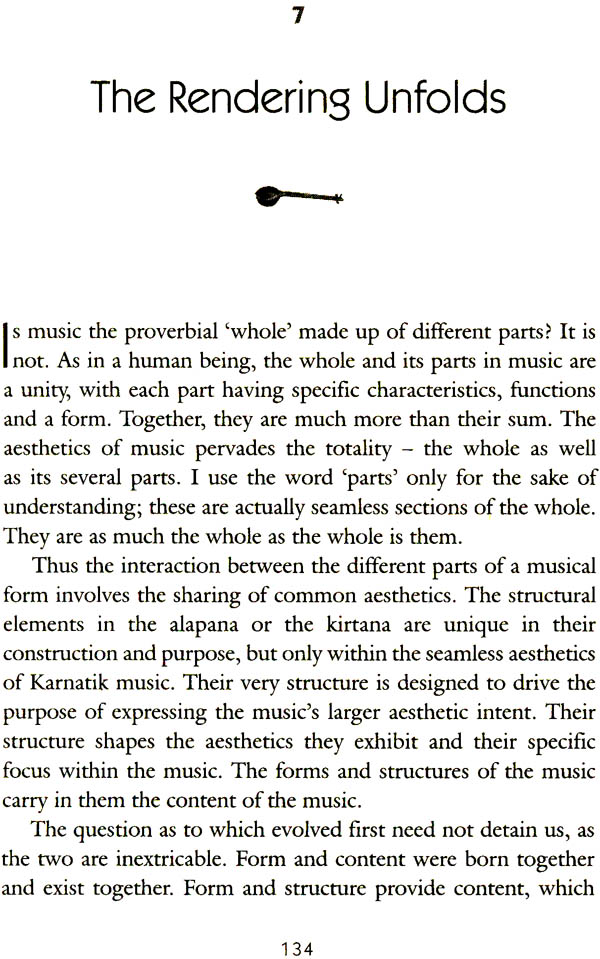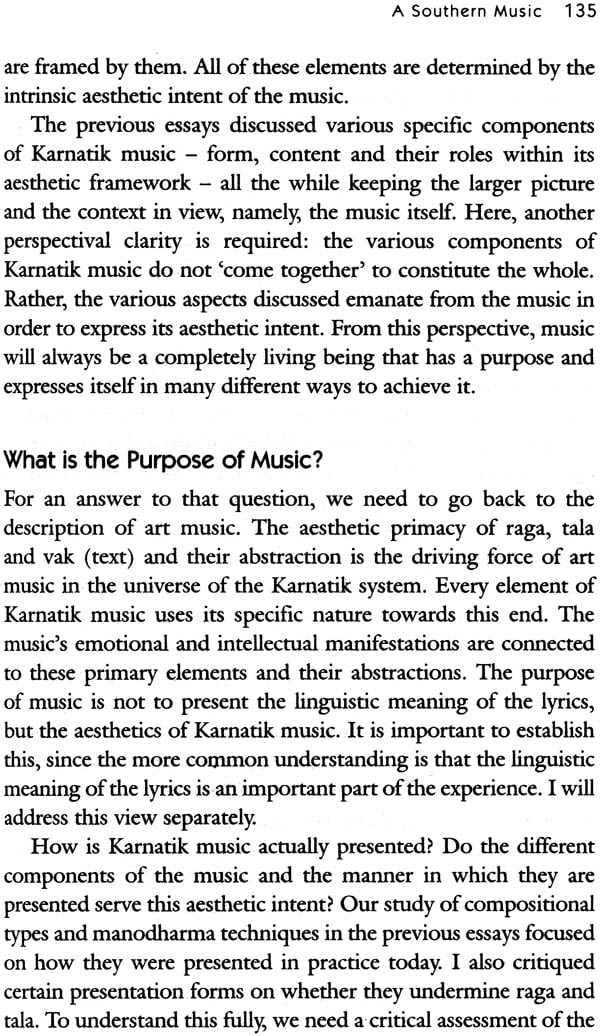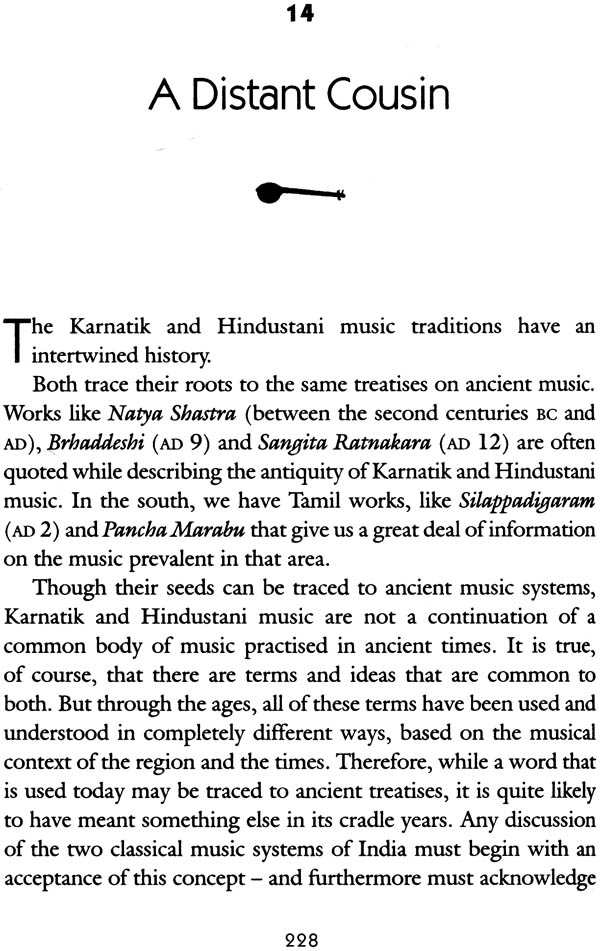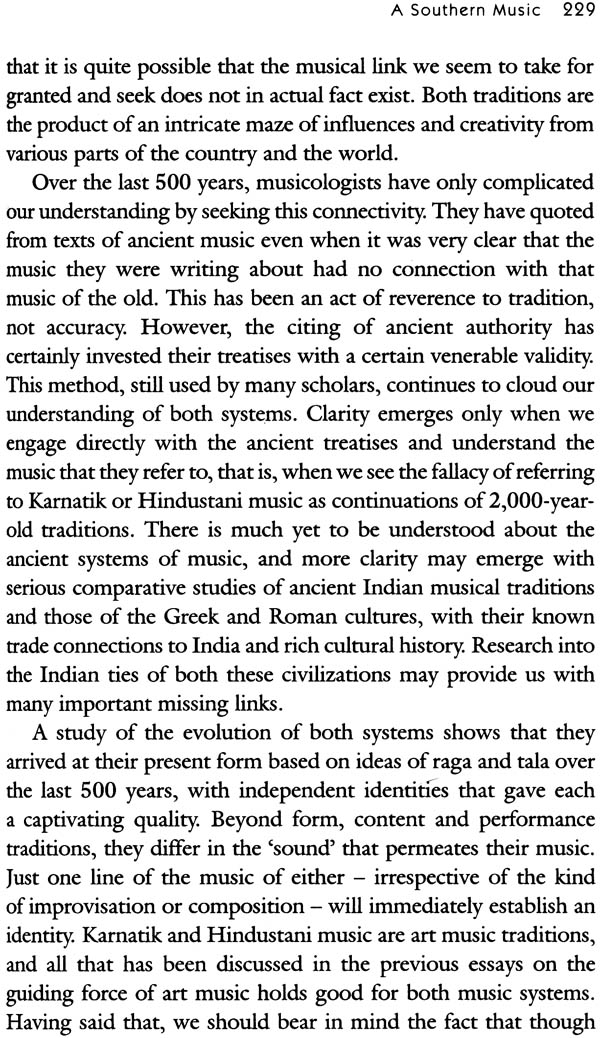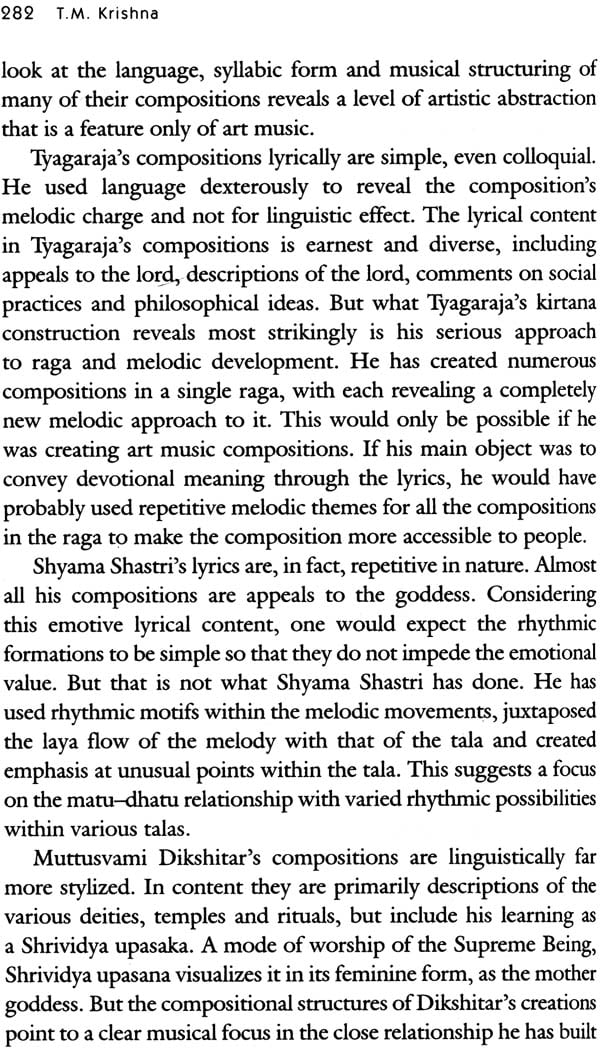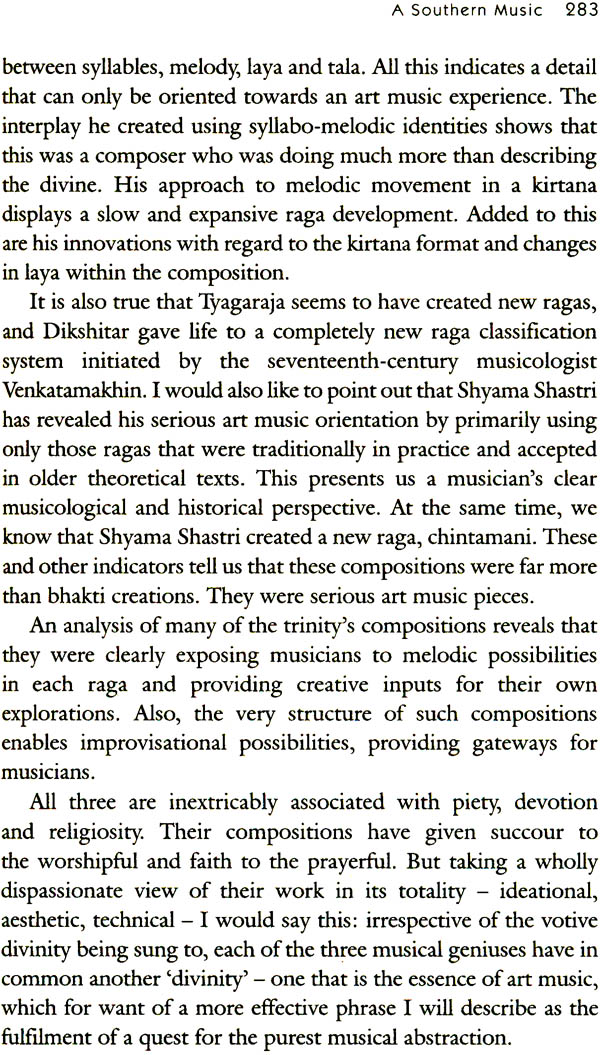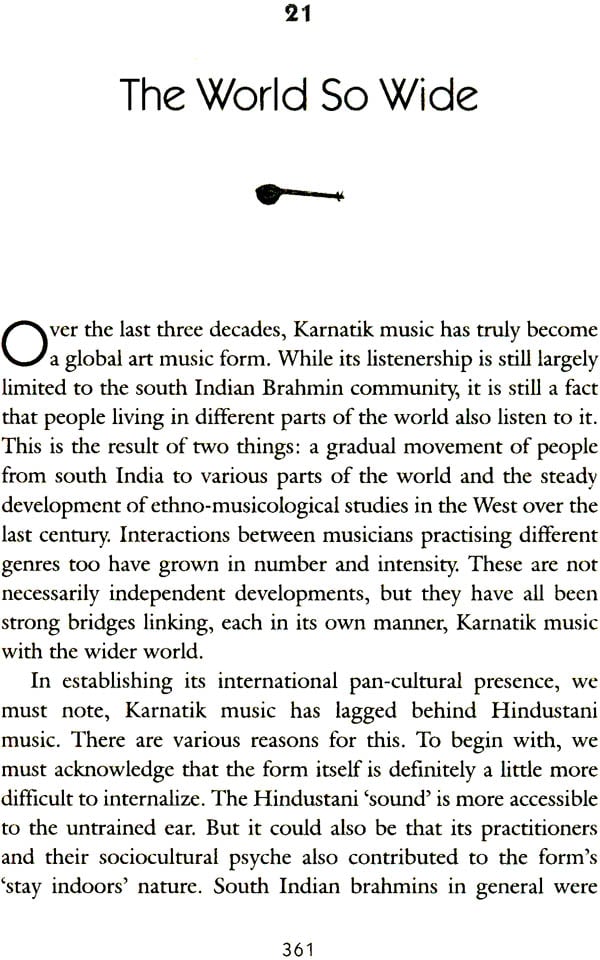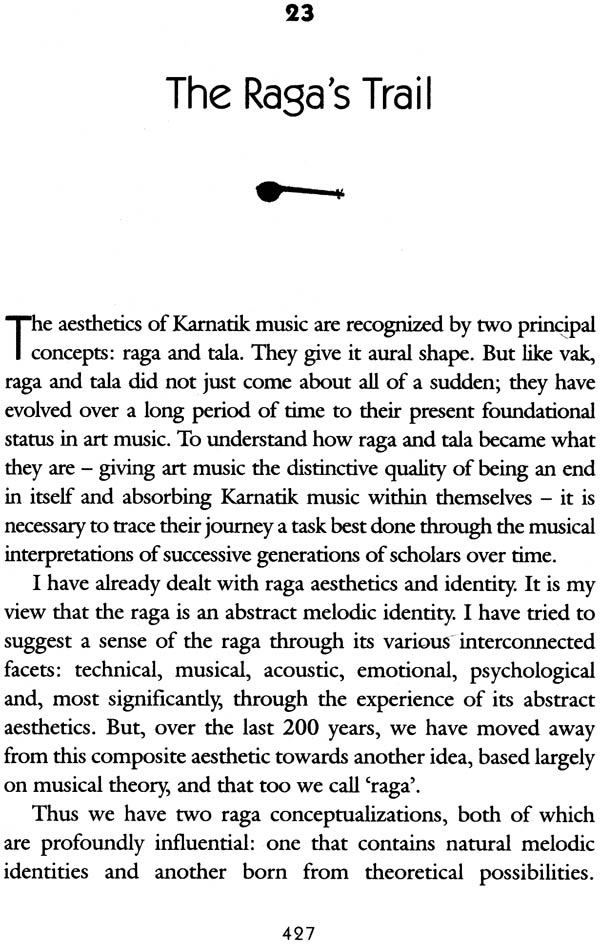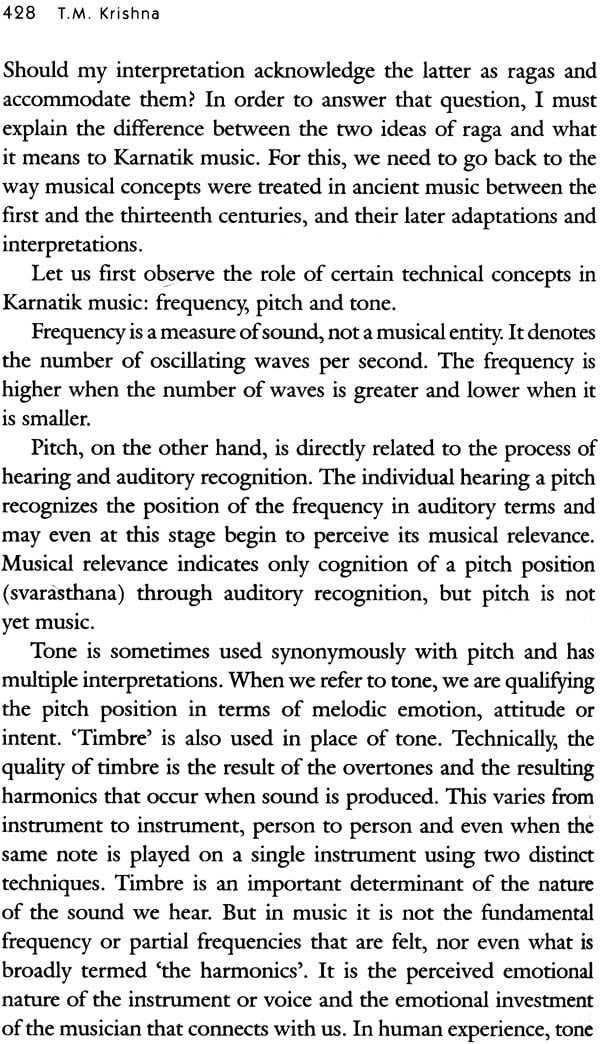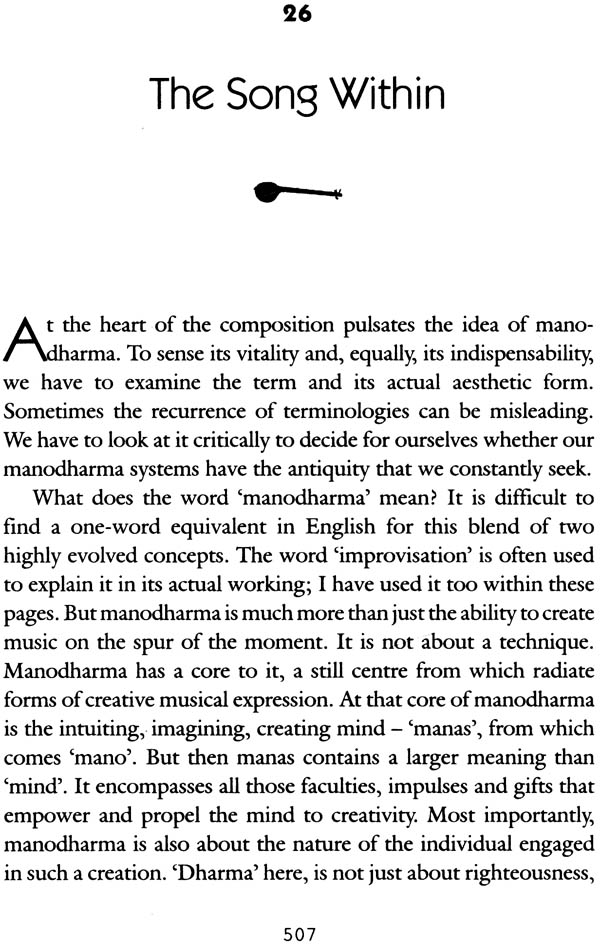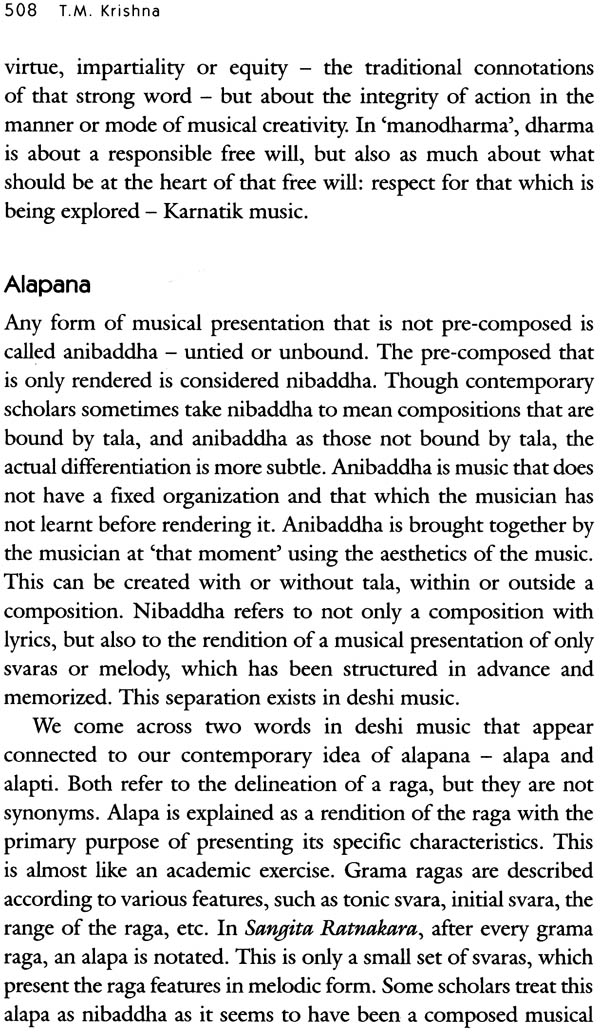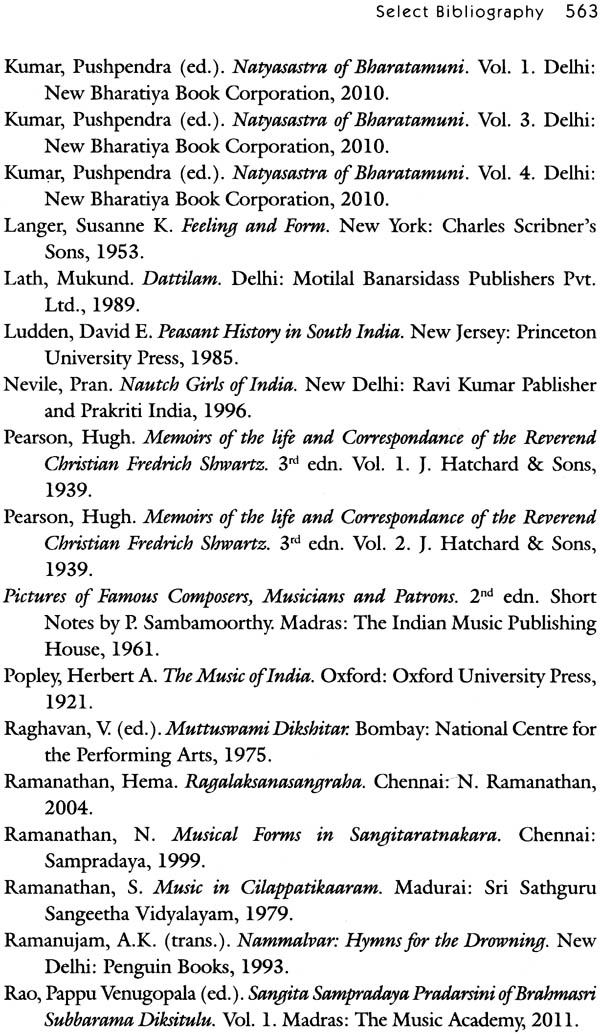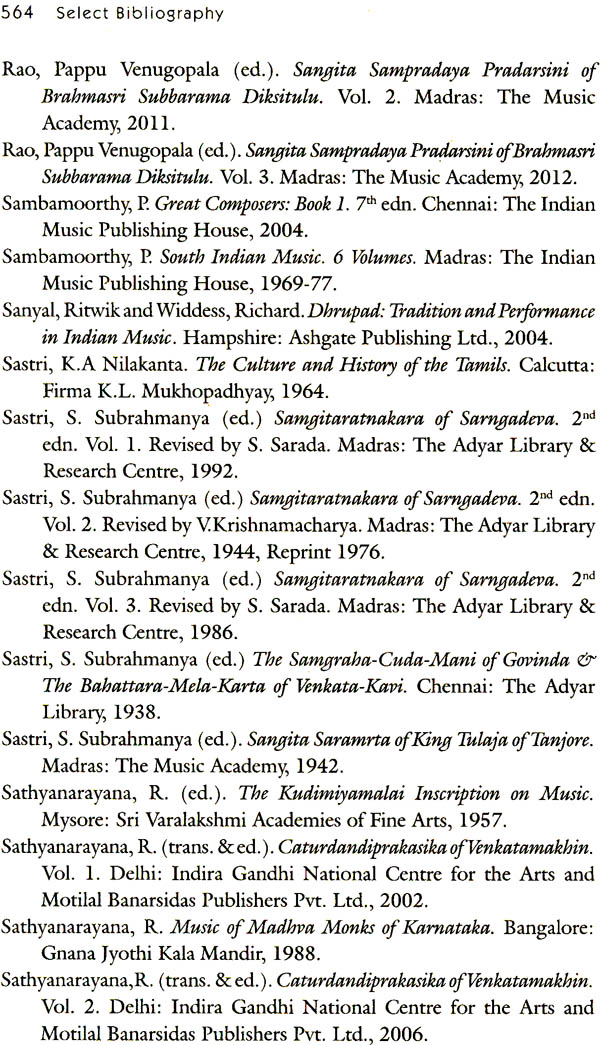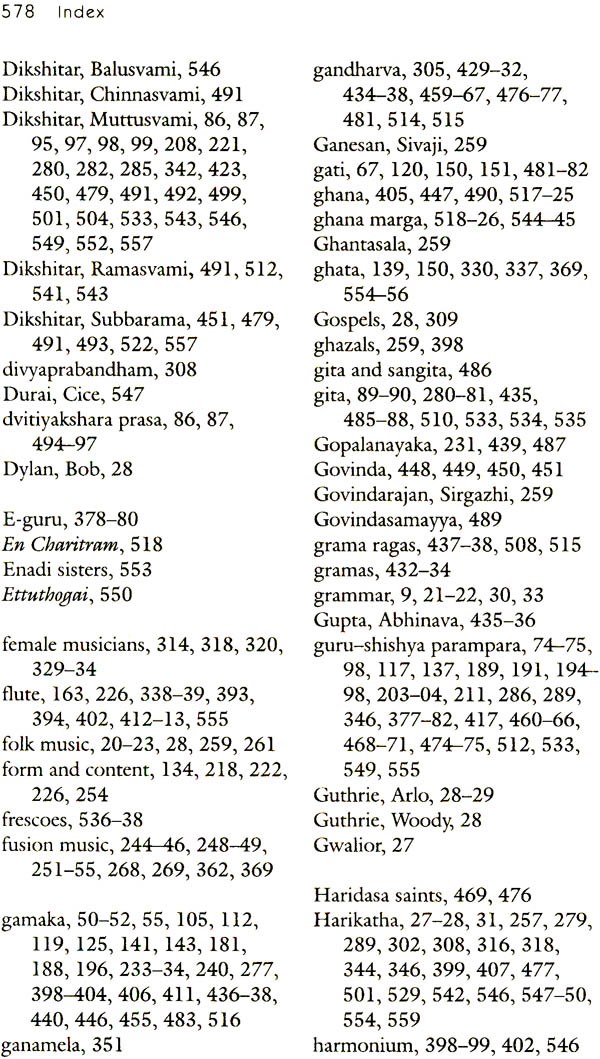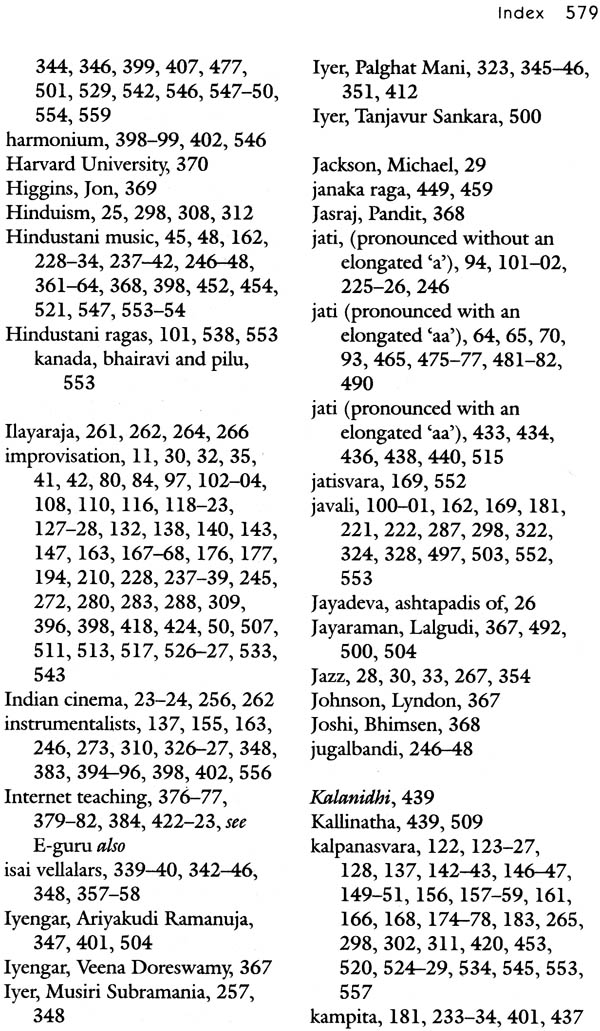
A Southern Music (The Karnatik Story)
Book Specification
| Item Code: | NAG345 |
| Author: | TM Krishna |
| Publisher: | Harper Collins Publishers |
| Language: | English |
| Edition: | 2015 |
| ISBN: | 9789350298213 |
| Pages: | 604 |
| Cover: | Paperback |
| Other Details | 8.5 inch X 6.0 inch |
| Weight | 700 gm |
Book Description
T.M. Krishna, one of the foremost Karnatik vocalists today, beings his panoramic exploration of that tradition with a fundamental question: what is music? Taking nothing for granted and addressing diverse readers from Karnatik music’s rich spectrum and beyond it, Krishna provides a path breaking overview of south Indian classical music.
He advances provocative ideas about various aspects of its practice, Central to his thinking is the concept of ‘art music’, the ability to achieve abstraction, as the foundational character of Karnatik music. Excavating its various elements and examining them up close, Krishan then unveils the majesty and grandeur of the form, in the process lending the reader a new eye with which to appreciate the music in its entirety.
But Karnatik music does not exist in isolation. In his explorations., he sights the visible connections and unappreciated intersections between this music form and others Hindustani music, Bharatanatyam, fusion music and cine music - treading new, often contentions, ground.
A Southern Music seeks to retrace the sources of Karnatik music even as it reflects on its self-renewing vitality today. To that end, Krishna examines a number of issues that Karnatik music must face up to: questions of gender and caste, the role of religion and of lyrics inspired by devotional sentiments, the diaspora and its relationship to ‘classical’ music, technology - and all this in a world that has opened up very fast and very emphatically to new experiences, yet closed its mind to much that is its priceless inheritance.
Unquestionably, the definitive book on Karnatik music.
Thodur Madabusi Krishna’s three-initialled renown as ‘TMK’ comes from his widely acknowledged statures as a vocalist in the Karnatik tradition. His musicality eludes standard analyses. Uncommon in his rendition of music and original in his interpretation of it, Krishna is at once strong and subtle, manifestly traditional and stunningly innovative.
He studies at the Krishnamurti Foundation’s The School in Chennai, and Jiddu Krishnamurti’s philosophy of ‘pathlessness’ has unmistakably influenced Krishna’s un-preconditioned journeys over the Karnatik continent. His musical grounding was honed into mastery under the tutelage of Vidvans seetharama Sarma, Chingleput Ranganathan and the legendary Semmangudi Srinivasier.
Krishna’s pen is sharp, his words blunt. He thinks upon and writes about issues affecting the human condition and about matters musical. He has started and is involved in many organizations whose work is spread across the whole spectrums of Karnatik music, including research, archiving and documentation, taking Karnatik music to smaller town and villages and supporting artists from rural south India. He has co-authored Voices Within: Carnatic Music - Passing on an Inheritance, a book dedicated to the greats of Karnatik music.
It is all too rare that a great artist reflects deeply, systematically and in a communicative manner on the particular artistic tradition of which he or she is a part. The very idea of such reflection is rather exotic, indeed improbable: a musician sings, a painter paints, a poet writes verses. The attempt to explain what goes on in the hidden reaches of the artist's mind may even be inimical to the actual business of making art happen. A Telugu verse, still circulating orally, tells us that it is fruitless, even ridiculous, to ask a poet about his own productions:
The beauties of a poem are best knuwn
by the critic.
What does the author know?
The beauties of a woman are known
only to her husband.
What does a father know?
But in the case of music, for example, who exactly is the father (or, for that matter, the husband)? The doubt voiced by the poem applies, mutatis mutandis, to great performers, who are, as everyone knows, creative artists in their own right. In short, 'doing' and 'reflecting' may well be mutually contradictory.
Some egregious examples come to mind, such as Glenn Gould's incomprehensible recorded talks on Bach's Goldberg Variations (a composition for which he gave us two very different, equally unforgettable renditions, the first recorded in 1955 and the second, shortly before his death, in 1981). When I first listened to the pedantic near-gibberish of these talks, I thought to myself: 'Please stop the torrent of words, just play the pieces!' A great musician always tells us - very eloquently - what he or she thinks just by making music, as a dancer does by dancing. But occasionally there is an exception to this rule, and the book before us surely fits this description. TM. Krishna is my favourite male vocalist of Carnatic music in this generation. He is a consummate master of the intricacies of this most subtle of musical traditions, with its vast expressive range enlivened by disciplined precision, sensitivity and nuance. I think: he preserves, in some natural and unprepossessing manner, something of the intimate, gentle, profoundly emotional character that was clearly central to modern Carnatic singing in its earlier, formative phase - at the Maratha Tanjavur court, for example, and later in the new middle-class salons that sprung up in places like Manali (near early-colonial Madras) and Ettayapuram. This artist is also very well aware of his place within the continually evolving tradition, and he has much to say about the practices of performance in its theoretical frame and historical contexts. He has, in effect, given us a detailed meditation on all major aspects of Carnatic music - a glimpse, one might say, from behind the visible surface of the kacceri, from some point deep within the artist's heart and mind, remote from the microphones and even from the magic of what we can hear with our ears. Interestingly, he also has much to say on ultra-modern musical forms, including film songs and popular music, which to his great credit he sees as, in some senses, continuous with the classical tradition.
There are fascinating discussions of specific, sometimes quite technical topics and domains (the long chapter on rhythm, for example; and the fine presentation of what rag a means to a performer). We also see an unusual historical sensibility informing the entire book and coming to sustained expression in the chapter on the evolution of Carnatic music over the last four centuries. A connoisseur of Carnatic singing will find here surprising articulations of what goes on in the mind of a supremely skilled performer in the course of a full-scale concert. How much is conscious at the moment when sound emerges from the throat (or perhaps from some more unfathomable place in the body)? How does the long process of training, replete with criss-crossing technical knowledge on many levels, translate into the gift of active interpretation of the musical and verbal texts? There are things that we, the listeners, will never know (and probably should not think too much about) - and yet a window, at moments amazingly transparent, has been opened for us by a performer of unimpeachable authority.
If I had to pick one topic of special importance, I would go for those passages where T.M. Krishna speaks of the performer's creative role vis-a-vis the composer and his texts. One could argue that, in this respect, both the Carnatic and the Hindustani streams allow, even require, the performer to go well beyond what is considered normative in Western classical music. Indeed, it is impossible even to begin to understand a Carnatic kriti in live performance without an awareness of this critical, active re-creation by the skilled performer. It is not only a matter of improvisation, at various possible points; rather, the creative Carnatic singer in some sense mingles with the composer throughout, a not unconstrained, yet surprisingly autonomous, partner to the expressive process. We have reason to be grateful to an artist who not only embodies this truth in practice, but who has also found accessible words to make sense of it.
This is a passionate book written by a person capable of strong feeling - capable, that is, of love. You can hear this personal quality, along with the tremendous force of practice and experience, in the way he writes: 'The raga exists in a trained listener's mind even before it is heard.' 'Time is not only a measure; it is a living entity that defines and redefines our sense of ourselves as individuals and as a people ... The most beautiful part of time in music is the idea of created time.' 'Creativity that is born out of purely structural rules that are imposed on a raga lacks the organic quality of creativity.' The author is therefore interested, as he tells us, in the way 'rules cease to be conditions'. He is sometimes ironic: 'We think of both a person standing on his head for twenty-four hours and a rendition of raga bhairavi by a vidvan as "awesome".' He can be refreshingly irreverent: 'The biggest problem with musicologists is that they study Carnatic music as a science.' Though he embodies a tradition given to various competing orthodoxies, he is open to experimentation. Thus, needless to say, passages of his book sound deliberately provocative and will certainly generate controversy, as befits a vital artistic tradition that has proven capable of repeatedly renewing, even re-imagining, itself over the course of six or seven generations. This book is testimony to that vitality. My hope is that it will reach readers who love Carnatic music without knowing much about it - without knowing why they love it - and that it will move people who have never heard a Carnatic kriti to discover what they have missed. As for the connoisseurs, T.M. Krishna has given them a candid view of how a true master of the art conceives of what he does, what he hears, what he has learnt, and what he thinks is still to come.
| Foreword | xi | |
| A Note on Reading | xv | |
| BOOK 1: THE EXPERIENCE | ||
| 1 | Music: A Narrative | 3 |
| 2 | The Intent of Music | 16 |
| 3 | Imagination, Creativity, Improvisation | 35 |
| 4 | The Fundamentals | 44 |
| 5 | The Tune in the Word | 71 |
| 6 | Creativity U nbound - Manodharma | 103 |
| 7 | The Rendering Unfolds | 134 |
| 8 | The Concert Unravels | 154 |
| 9 | The Karnatik Concert Today: A Critique | 164 |
| 10 | Voicing the Note | 185 |
| 11 | A Matter of Style | 193 |
| 12 | Studying the Song | 200 |
| BOOK 2: THE CONTEXT | ||
| 13 | A Song in the Dance | 215 |
| 14 | A Distant Cousin | 228 |
| 15 | The Melting Pot | 243 |
| 16 | The Sound of Cinema | 256 |
| 17 | Meaning the World | 272 |
| 18 | The Shrine and the Song | 294 |
| 19 | A Man's World | 314 |
| 20 | An Unequal Music | 335 |
| 21 | The World So Wide | 361 |
| 22 | The Musician and the Machi | 391 |
| BOOK 3: THE HISTORY | ||
| 23 | The Raga's Trail | 427 |
| 24 | The Tala's Beat | 458 |
| 25 | A Thing Composed | 485 |
| 26 | The Song Within | 507 |
| 27 | The Song on Stage | 531 |
| Epilogue | 559 | |
| Select Bibliography | 561 | |
| Acknowledgements | 570 | |
| Index | 574 |
